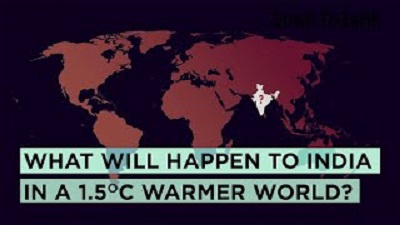Category : Climate Change | Location : National | Posted on 2022-09-28 23:00:02

An unprecedented heatwave hit India in March and April of 2022. It recorded the hottest March since record-keeping started in 1902. In fact, between March 11 and May 18, 2022, 16 states in India clocked a total of 280 heatwave days, the highest in the last 12 years.
All this happened in the year with a strong La Nina presence, a phenomenon known to bring more rainfall and cooler weather to the sub-continent.
Climate change is pushing up global temperatures. Currently, the world’s average temperatures have risen by about 1.1 degrees Celsius since pre-industrial times. According to the Intergovernmental Panel on Climate Change (IPCC), the average global temperature could breach the 1.5 degrees Celsius mark within the next 18 years.
If global temperatures breach this threshold, what will be the repercussions on India? How will this affect India in terms of temperature rise and rainfall? Will the entire country be equally affected or will certain parts of the country heat up more and get lesser precipitation?
Down to Earth analysed the latest reports of IPCC released in 2021 to see how temperature patterns and rainfall will change in a 1.5 degree Celsius warmer world. The findings of this analysis are quite alarming.
The Himalayan states and Union Territories of India will be the worst affected when global temperatures cross the 1.5 degree Celsius mark, according to this Down to Earth analysis. The union territory of Ladakh will be the worst hit with average temperatures likely to be higher by 2.23 degrees Celsius.
Jammu and Kashmir will be the next worst affected with 1.76 degrees Celsius; Temperature in Himachal Pradesh is likely to be higher by 1.73 degrees Celsius, while Uttarakhand and Sikkim will become warmer by 1.62 degrees and 1.55 degrees Celsius.
Temperatures in these five Himalayan states and union territories will be higher than the 1.5 degrees Celsius global average. The sixth Himalayan state, Arunachal Pradesh, will be warmer by 1.47 degrees Celsius.
India’s average temperature could be higher by 1.2 degrees Celsius, with temperatures in some states staying below the 1.5-degree mark, the DTE analyses found. Arid states like Rajasthan and Gujarat could become warmer by 1.43 and 1.33 degrees, respectively. Kerala at 1.31 degrees Celsius, Punjab at 1.27 degrees Celsius, and Chandigarh at 1.26 degrees Celsius will also see substantial temperature increases.
On the other hand, states like Jharkhand, Bihar, West Bengal and Odisha may record less than 1 degree Celsius temperature rise, keeping India’s overall temperature increase to 1.2 degrees Celsius. The rise in temperatures will also mean an increase in heatwave days across the country.
The India Meteorological Department considers a temperature over 40 degrees Celsius to declare a heatwave in non-hilly regions of the country. Going by this definition, Rajasthan will witness 13 additional days with temperatures upward of 40 degrees, Delhi and Gujarat will witness 12 such additional days, while Telangana and Andhra Pradesh will witness 10 and 8 days, respectively.
There is a good possibility that precipitation in India may increase by 10 per cent in a 1.5 degrees Celsius warmer world. But just like the temperature increase, this increase in rainfall may not be uniform across the country.
The northwest parts of India will see a higher increase in precipitation, with Rajasthan witnessing the highest increase at 22.87 per cent more rain than the 1850-1900 average.
Gujarat with 22.16 per cent and Punjab with 20.54 per cent will see the next highest increase in rainfall. Arunachal Pradesh, Sikkim and Andaman and Nicobar Islands are the only states and union territories that will see a rainfall deficit.
Northwest India shows both enhanced warming and a significant increase in rainfall, while Kerala, Tamil Nadu, and northeast India show enhanced warming, but only a nominal increase in rainfall or even a decrease in rainfall, the DTE analysis said.
Source: https://www.downtoearth.org.in/video/climate-change/what-will-happen-to-india-in-a-1-5-c-warmer-world--85163